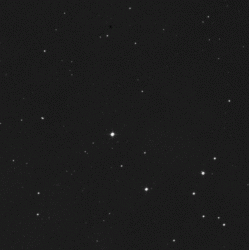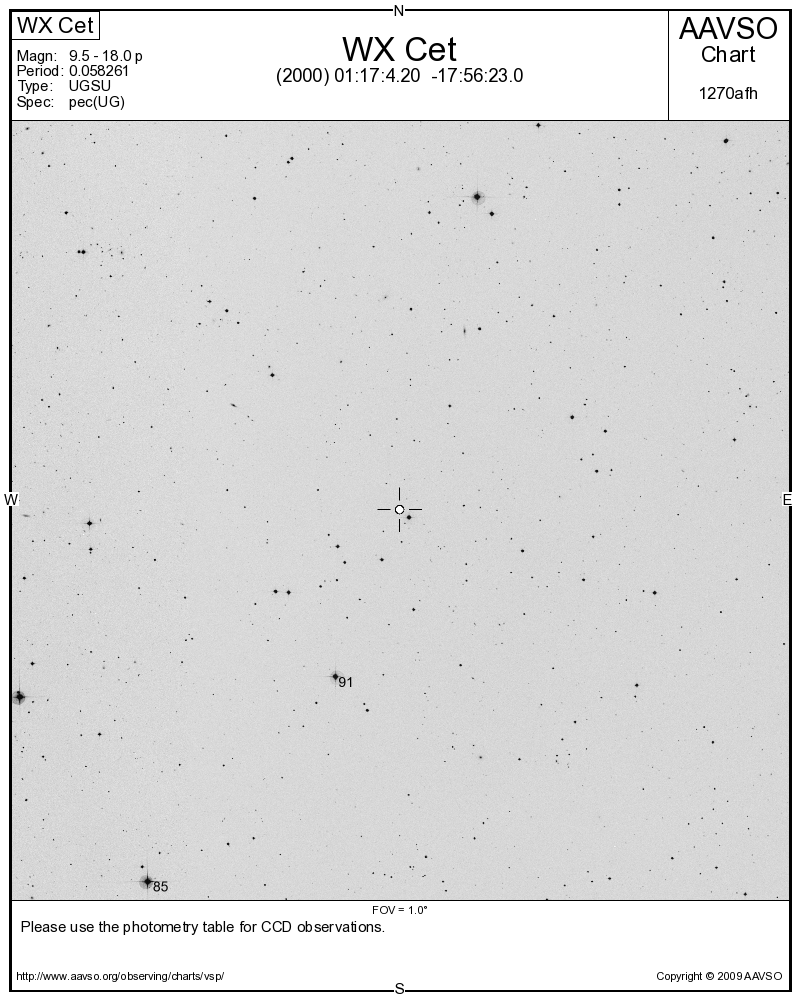According to AAVSO Special Notice #161 posted today by M. Templeton, dwarf nova WX Ceti is now in outburst and has been recorded at magnitude 12.62. There’s a lot to be learned about this cool little star…
Hazel McGee (Guildford, UK) has reported that the infrequently outbursting dwarf nova WX Ceti is in outburst. WX Ceti was recorded at a magnitude of 12.62 (clear filter, V zeropoint) on 2009 July 8.44375 (JD 2455020.94375). The observation was obtained remotely with GRAS-001 (New Mexico).
Follow-up observations of this outburst are urgently requested, including both visual estimates and instrumental photometry. CCD time-series observations capable of detecting possible superhumps
are particularly important. Please obtain the highest signal-to-noise data you can with the shortest exposures possible; filtered observations are not required. Please report all observations to the AAVSO with the name “WX CET”. Information on submitting observations to the AAVSO may be found at here and additional charts are available here.
WX Ceti is located at the following (J2000) coordinates: RA: 01 17 04.20 , Dec: -17 56 23.0
 So what kind of star is WX Ceti? Try a SU UMa type dwarf nova… but one with a superoutburst cycle that happens about every 880 days. But, WX is a bit different. It can have short eruptions every 200 days…. and apparently the outburst cycle length has doubled over the last 70 years. “According to our numerical simulations, this can be explained in the context of the disc instability model by assuming enhanced mass transfer during outburst and a decreasing mean mass transfer rate during the last decades. Using the data available, we refine the orbital period of WX Ceti to 0.0582610 ± 0.0000002 days and interpret the orbital hump found in quiescence as emission from the hot spot. During two recent superoutbursts in July 2001 and December 2004 we observed superhumps, with a rather large positive period derivative of Ps/Ps = 1.6 x 10-4, present only during the first 9 days of a superoutburst. Afterwards and during decline from the “plateau” phase, a constant superhump period of about 0.05922 days was observed. Late superhumps are present for at least 12 days after the decline from the “plateau”, with a period of 0.05927 days. We find this phenomenology difficult to interpret in the context of the standard explanation for superhumps, i.e. the thermal tidal instability model.” says C. Sterken (et al), “We interpret the long-term light curve of WX Cet as the result of a significantly decreasing mean mass transfer rate. Highlighting the complexity of the observed superhump light curves, we emphasise the importance of WX Ceti for a proper understanding of the SU UMa star outburst physics and the evolution of ultra-short period cataclysmic variables.”
So what kind of star is WX Ceti? Try a SU UMa type dwarf nova… but one with a superoutburst cycle that happens about every 880 days. But, WX is a bit different. It can have short eruptions every 200 days…. and apparently the outburst cycle length has doubled over the last 70 years. “According to our numerical simulations, this can be explained in the context of the disc instability model by assuming enhanced mass transfer during outburst and a decreasing mean mass transfer rate during the last decades. Using the data available, we refine the orbital period of WX Ceti to 0.0582610 ± 0.0000002 days and interpret the orbital hump found in quiescence as emission from the hot spot. During two recent superoutbursts in July 2001 and December 2004 we observed superhumps, with a rather large positive period derivative of Ps/Ps = 1.6 x 10-4, present only during the first 9 days of a superoutburst. Afterwards and during decline from the “plateau” phase, a constant superhump period of about 0.05922 days was observed. Late superhumps are present for at least 12 days after the decline from the “plateau”, with a period of 0.05927 days. We find this phenomenology difficult to interpret in the context of the standard explanation for superhumps, i.e. the thermal tidal instability model.” says C. Sterken (et al), “We interpret the long-term light curve of WX Cet as the result of a significantly decreasing mean mass transfer rate. Highlighting the complexity of the observed superhump light curves, we emphasise the importance of WX Ceti for a proper understanding of the SU UMa star outburst physics and the evolution of ultra-short period cataclysmic variables.”
What could cause this kind of behavior? Try a nearby white dwarf star. “We find that the accreting white dwarfs in VY Aquari and WX Ceti are remarkably similar. Both systems contain white dwarfs with Teff = 13,00013,500 K, a rotation velocity below 8001200 km s-1, and subsolar metallicity. Both white dwarfs are better fitted with a two-temperature white dwarf plus accretion belt model in which part of the white dwarf is cooler and “slowly” rotating and part is hotter, smaller, and spinning at the Keplerian speed.” says Edward M. Sion, “The occurrence of more outbursts on shorter timescales makes it likely that the accretion rates in VY Aqr and WX Ceti are somewhat higher than in the other systems. This possibility is supported by an increased amount of emission compared with the lowest accretion rate systems in our program. Moreover, there is less prominent absorption around the Balmer lines than in the other systems. The apparent presence of an accretion belt in VY Aqr and WX Ceti may be a direct result of the higher accretion. Surprisingly, the rotational velocities of VY Aqr and WX Ceti fall in the same range as the white dwarfs in LL And, SW UMa, HV Vir, BC UMa, EF Peg, EG Cnc, and other ultrashort-period, high outburst amplitude dwarf novae, viz., 200 to 500 km s-1. The abundances of photospheric metals at subsolar values for VY Aqr and WX Ceti, taken at face value, also appear to be a hallmark of the entire group. The evolutionary significance of the chemical abundances as well as the fate of the accreted angular momentum remain to be explained.”
Good luck and clear skies!
Finder chart courtesy of AAVSO, field image Palomar Observatory, courtesy of Caltech.


Err… I think that should read: Both systems contain white dwarfs with Teff = 13,000 to 13,500 K, a rotation velocity below 800 to 1200 km s-1, and subsolar metallicity.
Well, those differing rotation rates got my head spun all right. Wonder whether the “part of the white dwarf is cooler and “slowly” rotating and part is hotter, smaller, and spinning at the Keplerian speed” is referring to the dwarf plus accretion disc model or the dwarf as such? Any which way, two temperatures must have some interesting explanation.